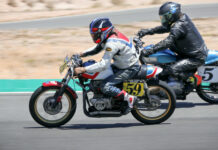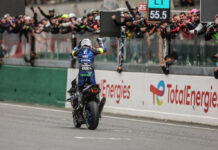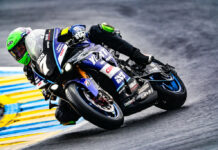FIM Superbike & Supersport World Championships and FIM Superstock 1000cc Cup
Decision of the Superbike Commission
The Superbike Commission, composed of Messrs Javier Alonso (WSBK Executive Director), Ignacio Verneda (FIM Executive Director, Sport) and Takanao Tsubouchi (MSMA Representative), met at Barcelona-Catalunya Circuit on 12 June in the presence of Messrs Daniel Carrera (WSBK Championship Director) and Gregorio Lavilla (WSBK Sporting Director ).
The meeting focused on two points:
1. SBK Technical Regulations 2015:
The main pillars of the technical regulation 2015 were approved by majority inside the Superbike Commission.
In 2015 the Championship will return to one technical platform. The rules were previously agreed to be as the 2014 EVO regulations and they have formed the basis of the 2015 rules. However amendments have been made to ensure parity of performance across the diverse range of machines in the championship and the regulations are also aimed at both reducing annual costs and making the Championship more accessible to new teams.
Chassis Regulations:
Remain largely unchanged excepting some clarifications to several points. The tolerances applied in measuring frames have been removed.
Engine Regulations:
The previously agreed EVO regulations form the basis of the 2015 rules. However due to the very limited options available to ensure parity of performance between different motorcycles the level of tuning opportunities has been increased.
The notable points are:
? Camshafts are free
? Cylinder head porting is free but no welding
? Valves, pistons and most major engine components must remain standard
? Con-rods may be replaced with similar material but equal weight parts for safety
? Crankcases standard
? One set of racing gearbox ratios allowed for the whole season
? Balancing rules no longer use weight, it will be intake restriction only
The FIM (Fédération Internationale de Motocyclisme) founded in 1904, is the governing body for motorcycle sport and the global advocate for motorcycling. The FIM is an independent association formed by 110 National Federations throughout the world. It is recognised as the sole competent authority in motorcycle sport by the International Olympic Committee (IOC). Among its 50 FIM World Championships the main events are MotoGP, Superbike, Endurance, Motocross, Supercross, Trial, Enduro, Cross-Country Rallies and Speedway. Furthermore, the FIM is also active and involved in the following areas: public affairs, road safety, touring and protection of the environment. The FIM was the first international sports federation to impose an Environmental Code in 1994.
Electronic Regulations:
The FIM Superbike World Championship remains the last high level championship open to the manufacturers to develop their electronic control strategies. The manufacturers will therefore be allowed to continue to develop the electronic solutions but these systems must be available to all other teams using the same make of machine and it will be called the ‘’Superbike Kit System’’.
The notable points are:
? Price limited Superbike Kit System available to all teams in World Superbike and other FIM championships
? Only approved ECU’s may be used in these kits – they will be race ECU’s
? The software of the factory team will be available to all other teams at three points during the racing season
? The Superbike Kit System must include all of the electronic parts not fitted to the standard street machine and required for the system to be fully operational (except the wiring harness)
? The selling price for the Superbike Kit System will be €8000
? Alternatively the Superstock Kit ECU may be used as in the 2014 EVO regulations, this is to encourage wildcard participation
Throttle Body Regulations:
For the 2015 and 2016 season the regulations will continue to allow the addition of Ride By Wire (RBW) systems to the throttle bodies. These systems must become available to all the other teams using the same machines. They will work hand in hand with the ‘’Superbike Kit Systems’’. For the 2017 season and onwards the regulations will mandate the use of the standard throttle bodies.
The notable points are:
? Ride by wire kits must be available to all teams in World Superbike and other FIM championships
? Only the machine manufacturer or one appointed supplier will be allowed to provide the kit (for safety)
? The price of the kits will be €2500
? All non RBW machines currently utilise a solution and the control strategies are mature
? Standard road bikes will adopt the use of this technology by 2017 meaning development continuity
*Complete provisional document will be available in the following days at FIM WEBSITE.
2. Additional engine allocation SBK category:
There was an official request from a team to slightly increase the number of engines available for 2014. The Superbike Commission refused this possibility by majority.






